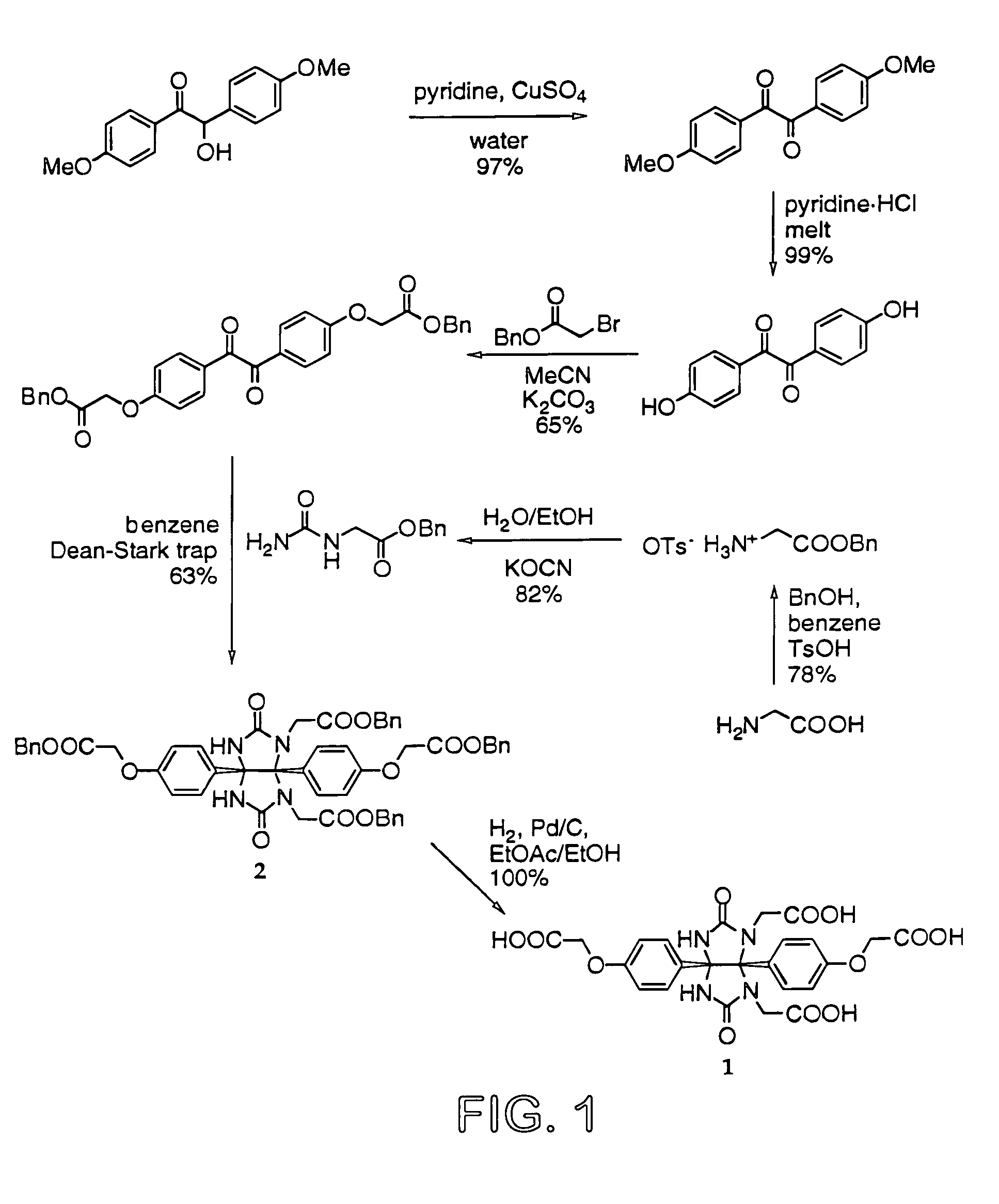Glycoluril core molecules for combinatorial libraries
a combinatorial library and glycoluril core technology, applied in the field of combinatorial chemistry, can solve the problems of difficult to assess the dimerization mode or ligand binding domain in the absence of three-dimensional structural information, size (2 to 20 residues) and the nature of ligands identified not immediately applicable as drug candidates
- Summary
- Abstract
- Description
- Claims
- Application Information
AI Technical Summary
Problems solved by technology
Method used
Image
Examples
example 1
General Methods
[0065]All reagents were purchased from Aldrich Chemical Company and were used without further purification except as noted. Amino acid esters, PyBOP, PyBrOP, and HATU were acquired from Novabiochem (San Diego, Calif.). Deuterated solvents were obtained from Cambridge Isotopes Laboratories and deuterated chloroform was dried over 4 Å molecular sieves. Citric acid and HCl refer to IN stock solutions. NMR spectra were recorded on either a Bruker AC-250, a Bruker AM-300, or a Bruker DRX-600; TMS was used as a reference in chloroform-d proton spectra; otherwise residual solvent was used as a reference. Either a Finnegan Mat 8200 (for HRMS / EI) or a VG ZABVSE (for HRMS / FAB) mass spectrometer was used to ascertain exact masses. FT-IR spectra were obtained on a Perkin Elmer Paragon 1000 PC FT-IR Spectrometer. Silica gel chromatography was performed with Silica Gel 60 (EM Science or Bodman, 230400 mesh). TLC analysis was performed using glass-bound Silica Gel 60 (F254) plates. ...
example 2
Preparation of Glycoluril dibenzyl ester (Compound 3a, FIG. 2)
[0066]Dibenzyl 4,4′-bis(carboxymethoxy)benzil (43.82 g, 81.4 mmol) and urea (14.68 g, 244.4 mmol) (NOTE: 2.5 equivalents can also be used successfully) were dissolved in 400 mL benzene. TFA (20 mL) was added and the solution was refluxed under a Dean-Stark trap in a nitrogen atmosphere for 16 h. EtOH was added to the cooled solution and the solid precipitate was isolated by filtration. The solids were purified by stirring overnight in boiling EtOH. The resulting solids were isolated by filtration and dried in vacuo, yielding a white powder (36.97 g, 73%). 1H-NMR (600 MHz, DMSO-d6): δ 7.65 (s, 4H), 7.33–7.38 (m, 10H), 6.94 (d, J=8.8 Hz, 4H), 6.65 (d, J=8.8 Hz, 4 H), 5.13 (s, 4H), 4.71 (s, 4H). 13C-NMR (151 MHz, DMSO-d6): δ 168.66, 160.79, 157.24, 135.82, 131.30, 128.60, 128.42, 128.34, 128.20, 113.55, 81.60, 65.98, 64.56. Calc'd for [C34H30N4O8+Cs+]: 755.1118; HRMS (FAB, NBA / CsI) found 755.1148. FT-IR (NaCl disc, cm−1): 32...
example 3
Preparation of Glycoluril diacid (Compound 3 from FIG. 2)
[0067]To a stirred suspension of glycoluril dibenzyl ester from Example 2 (1.00 g, 1.61 mmol) in 17.5 mL THF was added a solution of LiOH.H2O (0.16 g, 3.9 mmol) in 3.5 μL water. The resulting mixture was vigorously stirred at RT for 17 h. The mixture was poured into 90 mL HCl. The resulting white solids were isolated by filtration and were dried at elevated temperature, yielding the diacid (0.68 g, 96%). 1H-NMR (600 MHz, DMSO-d6): δ 7.66 (s, 4H), 6.94 (d, J=8.8 Hz, 4H), 6.62 (d, J=8, 7 Hz, 4H), 4.50 (s, 4H). 13C-NMR (151 MHz, DMSO-d6): δ 160.90, 157.58, 130.98, 128.42, 113.55, 81.69, 64.72, 21.09. Calc'd for [C20H18N4O8+H+]: 443.1203; HRMS (FAB, NBAINal) found 443.1233. FT-IR (DRAK, KBr, cm−1): 3381, 3221 (br., v.s.), 2361, 1726, 1684, 1610, 1513, 1476, 1445, 1419, 1302, 1235, 1185, 1110, 1074, 954, 839, 780, 737, 634. m.p. 287° C. (dec.)
PUM
| Property | Measurement | Unit |
|---|---|---|
| Structure | aaaaa | aaaaa |
Abstract
Description
Claims
Application Information
 Login to View More
Login to View More - R&D
- Intellectual Property
- Life Sciences
- Materials
- Tech Scout
- Unparalleled Data Quality
- Higher Quality Content
- 60% Fewer Hallucinations
Browse by: Latest US Patents, China's latest patents, Technical Efficacy Thesaurus, Application Domain, Technology Topic, Popular Technical Reports.
© 2025 PatSnap. All rights reserved.Legal|Privacy policy|Modern Slavery Act Transparency Statement|Sitemap|About US| Contact US: help@patsnap.com



